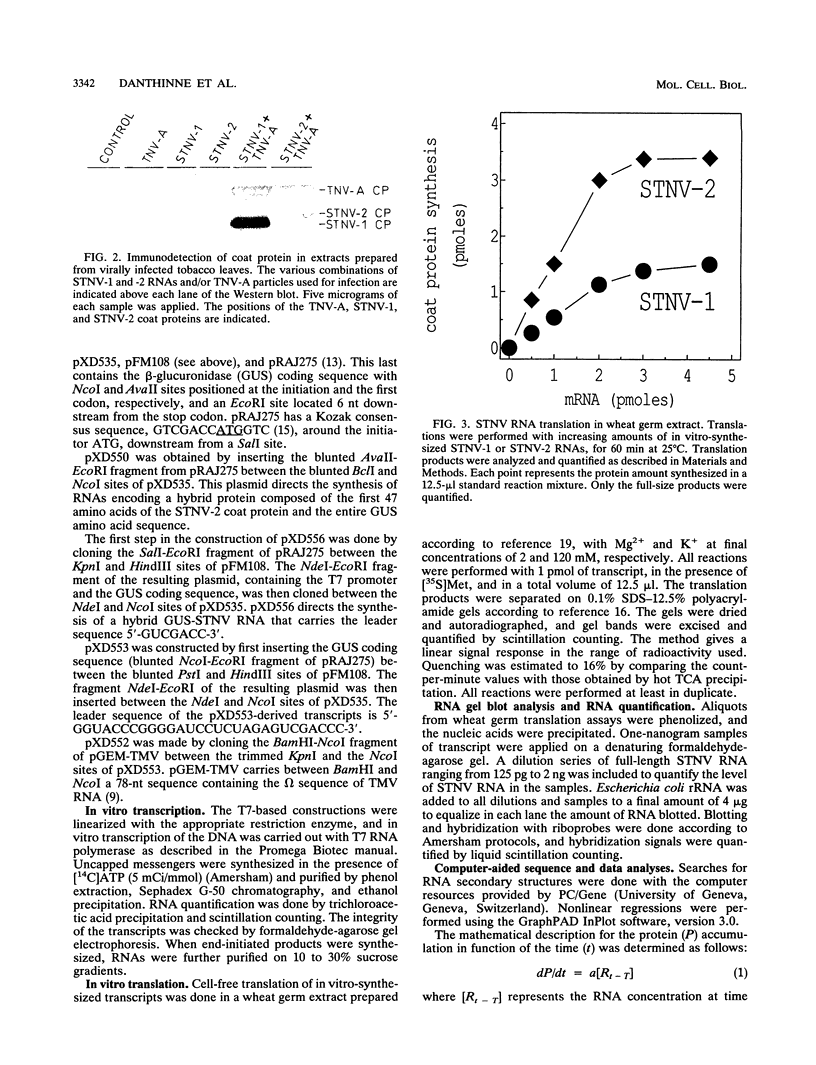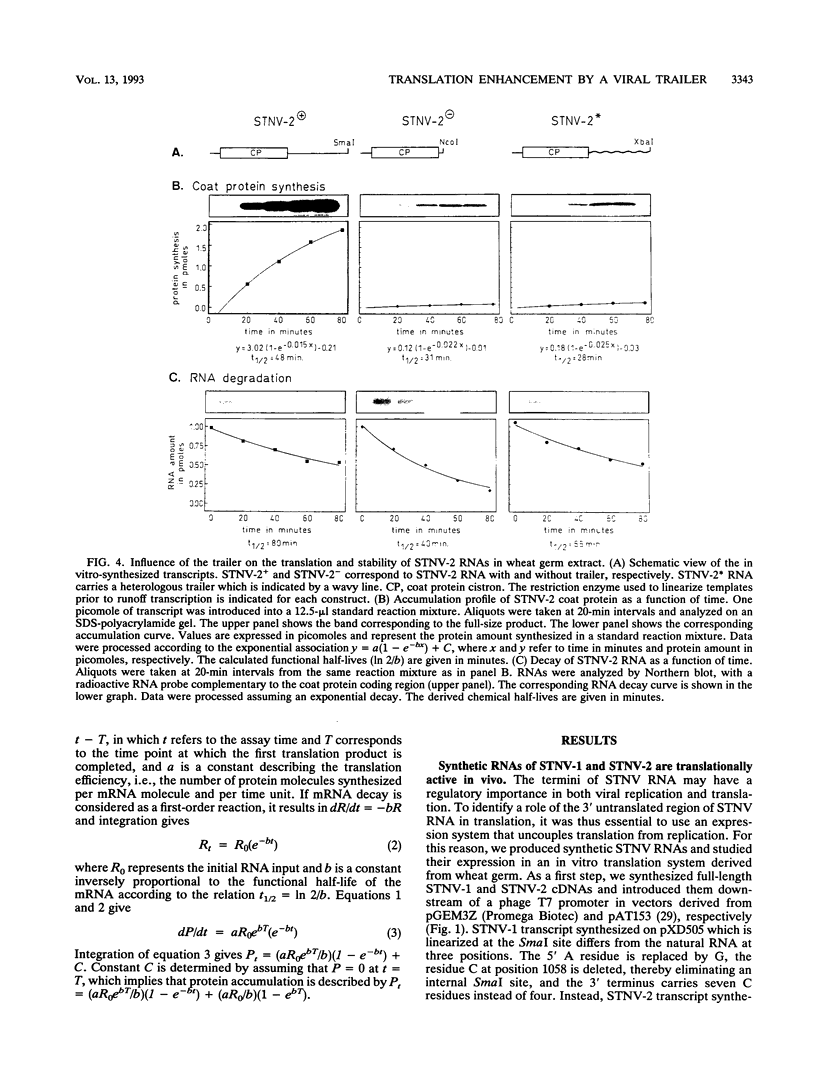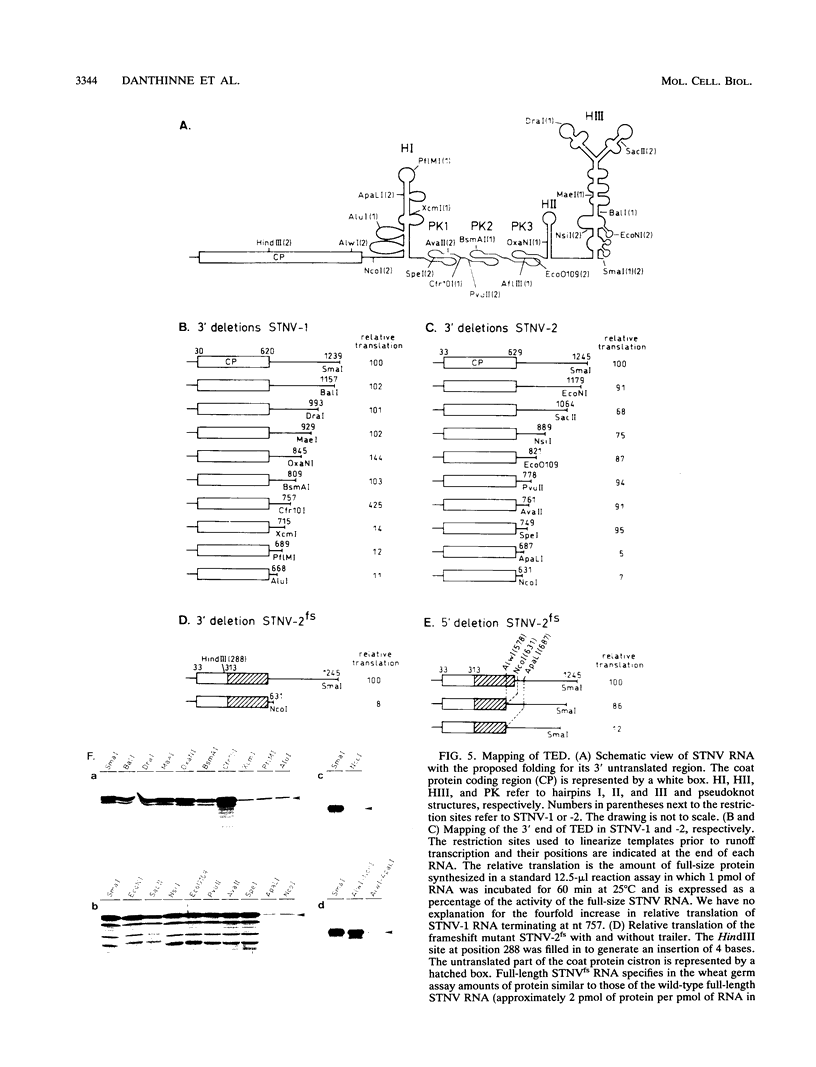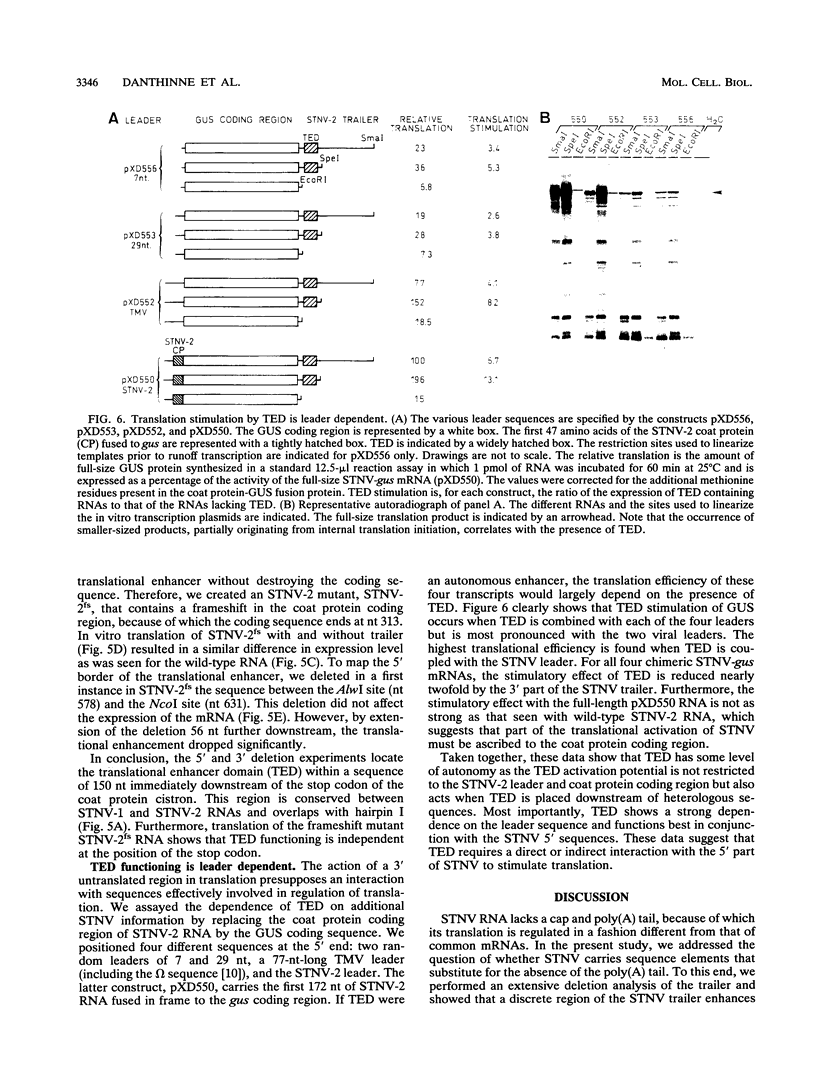Abstract
The RNA of satellite tobacco necrosis virus (STNV) is a monocistronic messenger that lacks both a 5' cap structure and a 3' poly(A) tail. We show that in a cell-free translation system derived from wheat germ, STNV RNA lacking the 600-nucleotide trailer is translated an order of magnitude less efficiently than full-size RNA. Deletion analyses positioned the translational enhancer domain (TED) within a conserved hairpin structure immediately downstream from the coat protein cistron. TED enhances translation when fused to a heterologous mRNA, but the level of enhancement depends on the nature of the 5' untranslated sequence and is maximal in combination with the STNV leader. The STNV leader and TED have two regions of complementarity. One of the complementary regions in TED resembles picornavirus box A, which is involved in cap-independent translation but which is located upstream of the coding region.
Full text
PDF









Images in this article
Selected References
These references are in PubMed. This may not be the complete list of references from this article.
- Anthony D. D., Merrick W. C. Eukaryotic initiation factor (eIF)-4F. Implications for a role in internal initiation of translation. J Biol Chem. 1991 Jun 5;266(16):10218–10226. [PubMed] [Google Scholar]
- Browning K. S., Fletcher L., Ravel J. M. Evidence that the requirements for ATP and wheat germ initiation factors 4A and 4F are affected by a region of satellite tobacco necrosis virus RNA that is 3' to the ribosomal binding site. J Biol Chem. 1988 Jun 15;263(17):8380–8383. [PubMed] [Google Scholar]
- Carrington J. C., Freed D. D. Cap-independent enhancement of translation by a plant potyvirus 5' nontranslated region. J Virol. 1990 Apr;64(4):1590–1597. doi: 10.1128/jvi.64.4.1590-1597.1990. [DOI] [PMC free article] [PubMed] [Google Scholar]
- Danthinne X., Seurinck J., Van Montagu M., Pleij C. W., van Emmelo J. Structural similarities between the RNAs of two satellites of tobacco necrosis virus. Virology. 1991 Dec;185(2):605–614. doi: 10.1016/0042-6822(91)90531-f. [DOI] [PubMed] [Google Scholar]
- Fletcher L., Corbin S. D., Browning K. S., Ravel J. M. The absence of a m7G cap on beta-globin mRNA and alfalfa mosaic virus RNA 4 increases the amounts of initiation factor 4F required for translation. J Biol Chem. 1990 Nov 15;265(32):19582–19587. [PubMed] [Google Scholar]
- Galili G., Kawata E. E., Smith L. D., Larkins B. A. Role of the 3'-poly(A) sequence in translational regulation of mRNAs in Xenopus laevis oocytes. J Biol Chem. 1988 Apr 25;263(12):5764–5770. [PubMed] [Google Scholar]
- Gallie D. R., Sleat D. E., Watts J. W., Turner P. C., Wilson T. M. A comparison of eukaryotic viral 5'-leader sequences as enhancers of mRNA expression in vivo. Nucleic Acids Res. 1987 Nov 11;15(21):8693–8711. doi: 10.1093/nar/15.21.8693. [DOI] [PMC free article] [PubMed] [Google Scholar]
- Gallie D. R., Walbot V. RNA pseudoknot domain of tobacco mosaic virus can functionally substitute for a poly(A) tail in plant and animal cells. Genes Dev. 1990 Jul;4(7):1149–1157. doi: 10.1101/gad.4.7.1149. [DOI] [PubMed] [Google Scholar]
- Horst J., Fraenkel-Conrat H., Mandeles S. Terminal heterogeneity at both ends of the satellite tobacco necrosis virus ribonucleic acid. Biochemistry. 1971 Dec 7;10(25):4748–4752. doi: 10.1021/bi00801a022. [DOI] [PubMed] [Google Scholar]
- Jackson R. J., Standart N. Do the poly(A) tail and 3' untranslated region control mRNA translation? Cell. 1990 Jul 13;62(1):15–24. doi: 10.1016/0092-8674(90)90235-7. [DOI] [PubMed] [Google Scholar]
- Kaempfer R., van Emmelo J., Fiers W. Specific binding of eukaryotic initiation factor 2 to satellite tobacco necrosis virus RNA at a 5'-terminal sequence comprising the ribosome binding site. Proc Natl Acad Sci U S A. 1981 Mar;78(3):1542–1546. doi: 10.1073/pnas.78.3.1542. [DOI] [PMC free article] [PubMed] [Google Scholar]
- Kozak M. The scanning model for translation: an update. J Cell Biol. 1989 Feb;108(2):229–241. doi: 10.1083/jcb.108.2.229. [DOI] [PMC free article] [PubMed] [Google Scholar]
- Laemmli U. K. Cleavage of structural proteins during the assembly of the head of bacteriophage T4. Nature. 1970 Aug 15;227(5259):680–685. doi: 10.1038/227680a0. [DOI] [PubMed] [Google Scholar]
- Maliga P., Sz-Breznovits A., Márton L. Streptomycin-resistant plants from callus culture of haploid tobacco. Nat New Biol. 1973 Jul 4;244(131):29–30. doi: 10.1038/newbio244029a0. [DOI] [PubMed] [Google Scholar]
- Maxam A. M., Gilbert W. A new method for sequencing DNA. Proc Natl Acad Sci U S A. 1977 Feb;74(2):560–564. doi: 10.1073/pnas.74.2.560. [DOI] [PMC free article] [PubMed] [Google Scholar]
- Munroe D., Jacobson A. Tales of poly(A): a review. Gene. 1990 Jul 16;91(2):151–158. doi: 10.1016/0378-1119(90)90082-3. [DOI] [PubMed] [Google Scholar]
- Pilipenko E. V., Gmyl A. P., Maslova S. V., Svitkin Y. V., Sinyakov A. N., Agol V. I. Prokaryotic-like cis elements in the cap-independent internal initiation of translation on picornavirus RNA. Cell. 1992 Jan 10;68(1):119–131. doi: 10.1016/0092-8674(92)90211-t. [DOI] [PubMed] [Google Scholar]
- Pleij C. W. Pseudoknots: a new motif in the RNA game. Trends Biochem Sci. 1990 Apr;15(4):143–147. doi: 10.1016/0968-0004(90)90214-v. [DOI] [PubMed] [Google Scholar]
- Sanger F., Nicklen S., Coulson A. R. DNA sequencing with chain-terminating inhibitors. Proc Natl Acad Sci U S A. 1977 Dec;74(12):5463–5467. doi: 10.1073/pnas.74.12.5463. [DOI] [PMC free article] [PubMed] [Google Scholar]
- Schimmel P. RNA pseudoknots that interact with components of the translation apparatus. Cell. 1989 Jul 14;58(1):9–12. doi: 10.1016/0092-8674(89)90395-4. [DOI] [PMC free article] [PubMed] [Google Scholar]
- Smith R. E., Clark J. M., Jr Effect of capping upon the mRNA properties of satellite tobacco necrosis virus ribonucleic acid. Biochemistry. 1979 Apr 3;18(7):1366–1371. doi: 10.1021/bi00574a037. [DOI] [PubMed] [Google Scholar]
- Sonenberg N. Picornavirus RNA translation continues to surprise. Trends Genet. 1991 Apr;7(4):105–106. doi: 10.1016/0168-9525(91)90440-2. [DOI] [PubMed] [Google Scholar]
- Twigg A. J., Sherratt D. Trans-complementable copy-number mutants of plasmid ColE1. Nature. 1980 Jan 10;283(5743):216–218. doi: 10.1038/283216a0. [DOI] [PubMed] [Google Scholar]
- Uyemoto J. K., Grogan R. G., Wakeman J. R. Selective activation of satellite virus strains by strains of tobacco necrosis virus. Virology. 1968 Mar;34(3):410–418. doi: 10.1016/0042-6822(68)90061-5. [DOI] [PubMed] [Google Scholar]
- Ysebaert M., van Emmelo J., Fiers W. Total nucleotide sequence of a nearly full-size DNA copy of satellite tobacco necrosis virus RNA. J Mol Biol. 1980 Nov 5;143(3):273–287. doi: 10.1016/0022-2836(80)90190-4. [DOI] [PubMed] [Google Scholar]
- Zuker M., Stiegler P. Optimal computer folding of large RNA sequences using thermodynamics and auxiliary information. Nucleic Acids Res. 1981 Jan 10;9(1):133–148. doi: 10.1093/nar/9.1.133. [DOI] [PMC free article] [PubMed] [Google Scholar]







